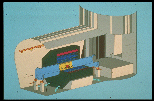Introduction to the L3 Experiment at LEP
Click on iconised images for an enlarged view.
L3 is a High Energy Physics Experiment running at the Large Electron Positron, or
LEP, collider, which is operated by
the European Organisation for
Nuclear Research (CERN) in
Geneva, Switzerland.
Click on the LEP map below for a perspective view.

The electrons (e-) and positrons (e+) are accelerated by the LEP machine to energies of approximately 45GeV
(48 times the proton mass)
and collided together at four equidistant points around the 27km LEP ring.
The e+ and e- annihilate to form a Z boson, the electrically neutral mediator of the Weak Interaction,
which subsequently decays into a fermion-antifermion pair.
The particles produced in these decays are observed in the four LEP detectors,
ALEPH,
DELPHI,
L3, and
OPAL,
which are situated in large underground experimental halls.
 Schematic view of the L3 underground experimental hall.
Schematic view of the L3 underground experimental hall.
The L3 detector in the final stages of construction is shown below, together with some of the 500 members of
the L3 collaboration, from
China, Europe, India, Russia, and the U.S.A.
 The L3 Collaboration beside the detector.
The L3 Collaboration beside the detector.
 End view of the completed L3 detector.
End view of the completed L3 detector.


 The L3 magnet.
The L3 magnet.

 The L3 support tube.
The L3 support tube.
The L3 detector comprises many sub-detectors

 Muon spectrometer octant.
Muon spectrometer octant.
 Hadron Calorimeter installed inside the support tube.
Hadron Calorimeter installed inside the support tube.

 The BGO crystal calorimeter during construction.
The BGO crystal calorimeter during construction.
L3 looks for events
 The L3 event scan program.
The L3 event scan program.
 The L3 Experiment in Pictures
The L3 Experiment in Pictures
 L3 Publications and Documentation
L3 Publications and Documentation
 L3 Analysis
L3 Analysis



![]() Schematic view of the L3 underground experimental hall.
Schematic view of the L3 underground experimental hall.
![]() The L3 Collaboration beside the detector.
The L3 Collaboration beside the detector.
![]() End view of the completed L3 detector.
End view of the completed L3 detector.
![]() Hadron Calorimeter installed inside the support tube.
Hadron Calorimeter installed inside the support tube.
![]()
![]() The BGO crystal calorimeter during construction.
The BGO crystal calorimeter during construction.
 The L3 Experiment in Pictures
The L3 Experiment in Pictures  L3 Publications and Documentation
L3 Publications and Documentation L3 Analysis
L3 Analysis 